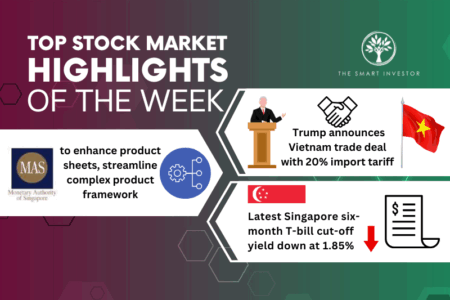It’s been a tepid earnings season for the REIT sector.
The combination of high interest rates and persistent inflation has resulted in lower distributions for a wide swath of REITs.
The industrial REIT space, however, has been more resilient as demand for industrial properties remains strong.
Investors should be familiar with two popular industrial REITs, namely Mapletree Logistics Trust (SGX: M44U), or MLT, and Mapletree Industrial Trust (SGX: ME8U), or MIT.
Both REITs have the same sponsor in Mapletree Investments Pte Ltd and we decided to compare these two REITs to see which makes the better investment.
Portfolio composition
First off, we look at the composition of each REIT’s portfolio.
MLT’s portfolio is larger than MIT’s with assets under management (AUM) of S$13.2 billion versus S$8.9 billion.
The logistics REIT also had more properties than its counterpart, at 187 versus 140.
Moreover, MLT is present in more countries than MIT and has exposure to Asian countries such as China, India, South Korea, and Japan.
MIT, on the other hand, has most of its portfolio concentrated in Singapore and the US.
In terms of industrial asset type, MIT has a slight advantage in having a greater diversity with business parks, data centres, and Hi-Tech buildings within its portfolio.
MLT has principally logistics properties within its portfolio.
Winner: MLT
Financials and DPU
Moving on to each REIT’s financials, MIT pulled off a slightly better top-line performance compared with MLT.
Gross revenue for MIT increased by 1.8% year on year versus just 0.4% for MLT.
Net property income also rose 0.6% year on year for MIT versus MLT being flat year on year.
However, MIT reported a 1% year on year fall in its distribution per unit (DPU) to S$0.1343 while MLT saw just a small 0.1% year on year dip to S$0.09003.
There is a twist here, though.
MIT’s latest fourth quarter of fiscal 2024 (4Q FY2024) saw gross revenue and DPU rise by 4.4% and 0.9% year on year, respectively.
MLT, on the other hand, reported that its DPU declined by 2.5% year on year for 4Q FY2024 despite enjoying a 1.2% year-on-year increase in its gross revenue.
Furthermore, MLT’s manager also warned that the cost of debt for replacement loans will be “significantly higher” than existing debt and that the continued weakness of regional currencies will pressure distributions.
Winner: MIT
Debt metrics
Next, we look at each REIT’s debt metrics.
Both MLT and MIT have roughly the same level of gearing which is comfortably below 40%.
MIT’s weighted average cost of debt is higher than MLT’s at 3.1% versus 2.7% but it balances this out with a better interest coverage ratio at 4.5 times versus MLT’s 3.7 times.
Both REITs also have almost the same proportion of fixed-rate debt that helps to mitigate a sharp rise in finance costs.
With MLT’s manager commenting that replacement loans will have significantly higher rates, we should see its weighted average cost of debt head higher in subsequent quarters.
MIT will emerge as the winner in this category as its interest coverage ratio will be higher than MLT’s should the latter’s interest expenses head higher.
Winner: MIT
Operating metrics
There is also no clear winner when we look at both REITs’ operating metrics.
MIT is bogged down by lower occupancy at its US data centre, which caused its portfolio occupancy rate to come in at 91.4%.
MLT, on the other hand, maintained a high portfolio occupancy of 96%.
On the flip side, MIT’s weighted average lease expiry (WALE) was longer than its counterpart at 4.4 years versus three years.
MIT’s rental reversion rate is also superior to MLT’s at 6.6% versus 2.9% as the latter’s rental reversion was dragged down by China’s negative rental reversion.
Investors should also note that MIT’s manager had warned that rental reversions should trend downwards to the 4% to 5% range in the coming quarters.
Winner: MLT
Distribution yield
Finally, we come to the arguably most important metric for income investors – each REIT’s distribution yield.
MLT has a higher distribution yield at 6.6% versus just 6.1% for MIT.
Winner: MLT
Get Smart: Not an easy decision
There is no easy way to determine which REIT is the better one.
Although MLT is more diversified and has a higher distribution yield, investors need to be mindful that finance costs look set to head higher and may impact distributions in the coming fiscal year.
Another aspect to look for is each REIT’s acquisition and divestment activity.
On this front, MLT seems more active in capital recycling with the acquisition of 12 properties and divestment of nine properties in FY2024.
MIT had less activity with just one acquisition of an Osaka data centre and the divestment of the Tanglin Halt Cluster.
Investors need to weigh each REIT’s merits and risks to decide on which to own.
In our latest report, we dive into five standout Singapore REITs offering distribution yields exceeding 5.5%. Why settle for less? Get more dividends hitting your bank account with our REITs guide. Click here to download for free now.
Follow us on Facebook and Telegram for the latest investing news and analyses!
Disclosure: Royston Yang owns shares of Mapletree Industrial Trust.





